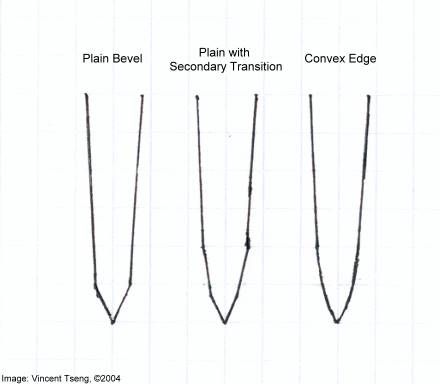I had an old thread that discussed convex edges -
Convexed Edge (link)
It's fairly easy to see the common single bevel - although can be sharp at the actual edge - presents a hard discontinuous shoulder at the face, resistance when cutting through things.
More sophisticated sharpening sometimes sets a secondary or transition bevel - this improves things - one can obviously do more transition/intermediate bevels to improve the cutting through ability -
but ultimately with enough transition angles/bevels one basically ends up with a convex edge.
I'm no a purist - but have honed freehand for years using a fine EZE lap diamond hone which removes metal pretty quickly and does not leave too coarse a finish - I then use a loaded leather strop (I think it's jeweler's rouge - but it looks like a piece of white chalk). But because I realize I am not consistent - I then actually use a 22.5deg V-hone round crock stick very lightly to set my final edge -
- then in idle moments I strop on a piece of cardboard -
this was a piece handed out by Ken Warner (editor of Knives 'xx for years)
In the field where compact and lightness is a premium - I would carry a short (4") fine ceramic round rod (failing that I'd just use the unglazed bottom of a mug or plate) and a piece of cardboard (or just find one). The ceramic rod probably can hone set almost any edge unless really dull to begin with - the cardboard can strop to a good finish and maintain a convex edge.
To start it's probably worth buying a convex edge knife than to modify a non-convex one.
Get one that is zero bevel - ie: does not have a separate bevel for the edge - the face continues into the edge.
Ken Warner Knives has both a folder (BGG) and fixed blade (SGG) that are relatively affordable -
the BlackJack Small - Kraton handle is still available as low as $25 shipped and is a great value for a zero-bevel convex knife (it is a bit thick - but makes up for it by the great convex edge -
Review -
BlackJack Small Comparison )
for prices do a google shopping search.
Hope that helps
--
Vincent
http://picasaweb.com/UnknownVincent?showall=true
http://UnknownVincent.Shutterfly.com
http://UnknownVT.Shutterfly.com
http://UnknownVT.multiply.com/photos

